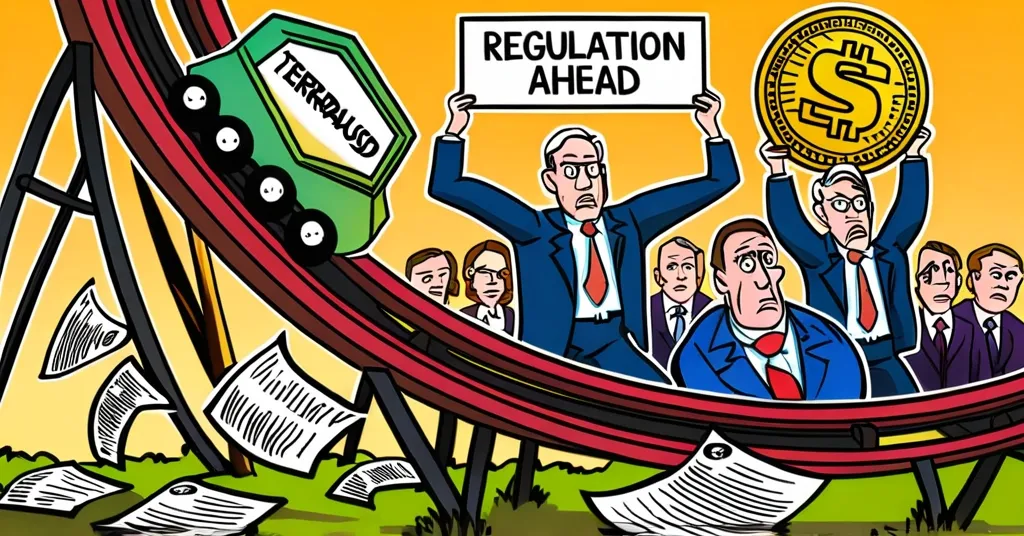Jump Crypto Unit Settles $123M with SEC Over TerraUSD Collapse, Faces Regulation Challenges

Jump Crypto Subsidiary Faces $123M SEC Settlement Over TerraUSD Debacle
In a significant development, Jump Crypto’s subsidiary, Tai Mo Shan, has settled with the U.S. Securities and Exchange Commission (SEC) for $123 million. This settlement stems from accusations of misleading investors about the stability of the TerraUSD (UST) algorithmic stablecoin.
- Tai Mo Shan agreed to a $123 million settlement with the SEC.
- Misleading stabilization efforts of UST involved a $20 million intervention.
- UST’s collapse in May 2022 prompted significant regulatory scrutiny.
- Jump Trading faces a lawsuit over alleged manipulation of the DIO gaming token.
Understanding Algorithmic Stablecoins
Algorithmic stablecoins, unlike traditional stablecoins backed by fiat currencies or other assets, rely on algorithms to maintain their value. These algorithms automatically adjust the supply of the stablecoin based on market demand to keep its value pegged, typically to the U.S. dollar. The TerraUSD was supposed to maintain its dollar peg through such mechanisms, but the system’s inherent flaws became apparent after a massive sell-off in May 2022, leading to its collapse.
The Impact of TerraUSD Collapse
The collapse of UST was not just a financial blow but a wake-up call about the risks associated with algorithmic stablecoins. The incident highlighted how these financial instruments could lead to significant investor losses if their complex mechanisms fail. SEC Chair Gary Gensler noted, “The impact reverberated throughout the crypto markets, eventually costing the savings of countless investors.”
This collapse has had widespread implications, prompting regulatory bodies to reassess their stance on such financial products. As a direct result, the Lummis-Gillibrand Stablecoin Act has been proposed, which seeks to prohibit algorithmic stablecoins in the United States, marking a potential turning point in digital asset regulation.
Regulatory Reactions and Future Prospects
Increased scrutiny from regulators like the SEC represents a critical shift towards ensuring transparency and stability in the crypto market. The $123 million settlement against Tai Mo Shan underscores the SEC’s commitment to holding firms accountable for deceptive practices and securing investor trust in the cryptocurrency space.
However, this regulatory push could also stifle innovation within the ecosystem. While rules are necessary to protect investors, overly stringent regulations might deter experimentation and development of new technologies. The balance between innovation and regulation will be crucial as the crypto space continues to evolve.
Jump Trading Lawsuit: A Separate Controversy
Compounding these challenges, Jump Trading is embroiled in a lawsuit with Fracture Labs, accusing it of market manipulation involving the DIO gaming token. This alleged “pump and dump” scheme led to a dramatic fall in the token’s value from $0.98 to $0.005. Such accusations highlight the volatile and often opaque nature of crypto trading practices.
This lawsuit further exemplifies the need for stricter oversight and regulation to prevent market manipulation and protect participants from fraudulent activities. As Gensler remarked, “Regardless of the labels, crypto market participants should comply with the securities laws where applicable and not deceive the public.”
Lessons for the Crypto Community
The TerraUSD collapse and the subsequent legal battles serve as a cautionary tale for the cryptocurrency community. Here are important takeaways:
- Understanding the distinction between algorithmic and traditional stablecoins is crucial for assessing investment risks.
- The failure of TerraUSD underscores the importance of rigorous risk management strategies for investors.
- Increased regulation may reshape the digital asset landscape, potentially curtailing risky ventures while encouraging safer practices.
As the crypto industry navigates these turbulent waters, embracing transparency and compliance with regulatory frameworks will be vital. Only by doing so can market participants ensure sustainable growth and maintain the trust of investors in this rapidly advancing financial frontier.



